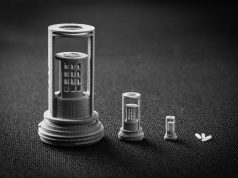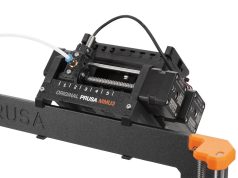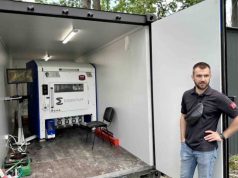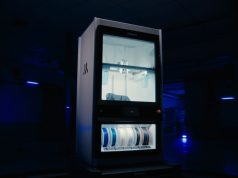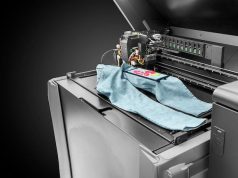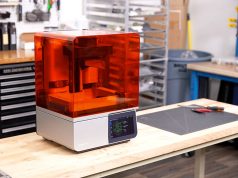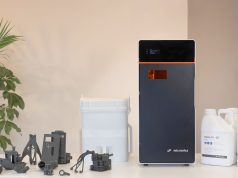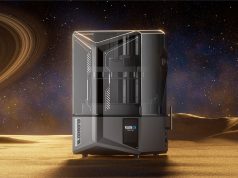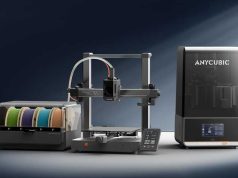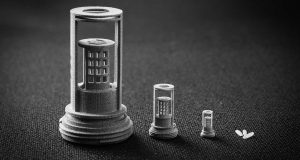Since the invention of Admaflex lithography-based additive manufacturing technology in 2013, many technological improvements have become available, enabling the printing of ceramics and metals on one machine and higher resolutions. So here is an overview of the new Admaflex300 from Admatec.
The Admaflex300 is currently available more than 12 million pixels per single layer, dramatically increasing the throughput and efficiency in high accurate technical ceramic and metal 3D printing.
Current state of the art light engines suitable for ceramic and metal printing have 4K projectors (2560×1600 pixels). When working with a pixel resolution of 40 µm, this results in a build platform size or projection area of 102×64 mm. The Admaflex300 is currently available with a pixel resolution of 40 µm and projection size of 202×102 mm, meaning more than 12 million pixels per single layer, dramatically increasing the throughput and efficiency in highly accurate technical ceramic and metal 3D printing.
Why lithography based 3D printing technical ceramics and metals
Technical ceramics are used when other materials fail, because of limited hardness, corrosion resistance or temperature resistance. To shape technical ceramics, there are several solutions, such as pressing, which has limited design freedom, or injection moulding which requires to produce first a mould. Ceramic and metal 3D printing can offer solutions to produce complex shapes directly from a CAD file, without the need of a mould, with comparable material properties as traditionally produced ceramics, when using the appropriate 3D printing technology, materials and furnaces.
Compared with direct laser based printing techniques, lithography-based ceramic and metal printing allows the finest details and highest resolution. After sintering, smooth and stress-free end-use parts are obtained, which usually do not require post-processing. The post-processing equipment is comparable as for CIM and MIM green parts, which makes the technology relatively easy to implement.
Application fields
3D printed high performance ceramic and stress-free sintered metal parts are used in many applications, such as (nuclear) energy, aviation, aerospace, defence, medical tools, R&D, catalysis, refractories, chemical industry, electronics, semiconductor, CO2 capture, refractories, aesthetics, jewellery and watches, opto-mechatronics, and many more. Next to the full dense ceramics, also porous ceramics are available, such as bonelike materials for patient specific medical implants and leachable ceramics to produce ceramic cores and shells for investment casting.
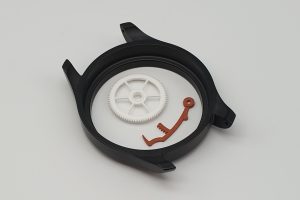
Why slurry-based 3D printing
If the aim is to have full dense technical ceramic products with high strength and smooth surfaces, ceramic particles with very small grain sizes are needed, as these allow full densification during sintering. Very fine powders cannot be processed safely in a dry powder bed, however a proven solution is to work with pastes or slurries. By using slurries consisting of highly ceramic filled UV sensitive resins, 3D printing is possible with high resolutions (<50 µm) and after postprocessing in debinding and sintering furnaces, high quality parts can be obtained.
Why Admaflex technology
When printing ceramics and metals, a printing system is needed which can handle high viscosity slurries without risk of sedimentation. In 2013, Admatec developed an innovative new printing technology which combines tape casting (for slurry depositioning) with Digital Light Processing (UV curing using stereo lithography) to produce ceramic parts. Since the introduction of the Admaflex130 printer in 2016, many machines using this Admaflex technology have been delivered worldwide, at renowned ceramic and metal parts producers, 3D printing contract manufacturers, Universities and governmental labs, who have proven the ability to shape and sinter high quality ceramic and metal parts with excellent material properties and narrow tolerances, typically using high resolutions between 40 and 50 µm.
Advancements in Lithography based Ceramic and Metal Additive Manufacturing
When the lithography based ceramic additive manufacturing technologies and systems were introduced in 2013, the “full HD” lightengine with 1920×1080 pixels was the most used UV source. The full HD projector allowed projection areas of 96×54 mm at a resolution of 50 µm. In 2018, more and more printing systems were delivered with WQXGA lightengine, offering 2560×1600 pixels, meaning a total of 4.096.000 pixels therefore also called 4K. When working with a pixel resolution of 40 µm, this usually results in a projection size of 102×64 mm. The Admaflex130 is currently standard equipped with WQXGA lightengine, which can be adjusted to pixels resolutions between 35 and 62,5 µm, making this machine ideal voor R&D, material development and producing small series of compact parts. Materials have been added such as non-oxide ceramics, copper, silver and other precious metals.
Advancements in projection technologies and throughput
The Lithography based Ceramic and Metal Additive Manufacturing technique uses Digital Light Processing technology, which cures a next layer of a full build platform in a few seconds. In combination with tape casting to deposit a new slurry layer, it allows to increase printing speeds up to 300 layers per hour. Since 2019, Admatec offers the Admaflex300 machine, which can be tailored to the needs of the customer, with different projection sizes and resolutions. Currently, the Admaflex300 is available with pixel resolution of 40 µm in combination with an impressive build platform of 202×102 mm, meaning more than 12 million pixels in one single layer. Compared with machines with traditional projection technique, meaning one projection of 102×64 mm at 40 µm, the Admaflex300 dramatically increases the throughput and efficiency in highly accurate technical ceramic and metal 3D printing.
To answer the question “should I choose one big Admaflex300 printer or 3 smaller Admaflex130 machines” it is good to know that the investment cost for an Admaflex300 is only 50% more compared with the Admaflex130 with comparable capabilities. If your aim is R&D and material development with the smallest amount of material, the Admaflex130 is the best solution for small parts. If you plan to scale up to maximum productivity, the Admaflex300 will be the most economical solution, with more than 3 times the production output of a smaller machine with 102×64 mm platform. In case you have budget for the Admaflex130 but not sufficient for the Admaflex300, you could even consider an Admaflex300 with specifications like the 130 machine at the pricelevel of the 130 machine, still allowing you to upgrade lateron to the full capabilities and specifications of the Admaflex300 machine.
To find out more about Admatec visit admateceurope.com.
Subscribe to our Newsletter
3DPResso is a weekly newsletter that links to the most exciting global stories from the 3D printing and additive manufacturing industry.




